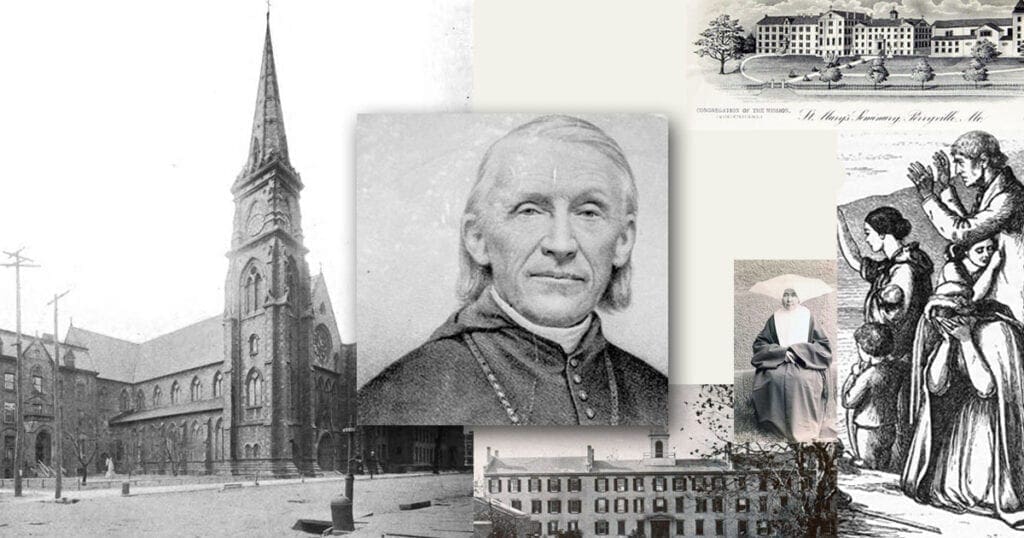April 16 is the anniversary of the death of Bishop John Timon, C.M., the first provincial superior of the American province of the Congregation of the Mission and one of the giants of the early U.S. Catholic Church. He established and/or encouraged many charitable and educational institutions to meet the most pressing social needs of his time.
Bishop John Timon, CM
Timeline
- Born to Irish immigrants at the old Catholic settlement of Conewago in Lancaster County, Pennsylvania, on 12 February 1797
- Grew up in Baltimore, working for the family dry goods business. The family moved several times, to Louisville, KY and finally to Saint Louis in 1819
- He determined to join the priesthood after a crisis which wiped out the family’s finances
- Discerned his vocation to the priesthood under the influence of Felix De Andreis, C.M.
- Entered Saint Mary’s of the Barrens Seminary (the Vincentian frontier seminary outside of St. Louis) beginning in 1823
- Ordained to the priesthood by Bishop Joseph Rosati on 23 September 1826
- Spent the early years of his priesthood in teaching at the seminary
- During the summers did missionary work, up and down the Mississippi River and in Texas, with Jean-Marie Odin, C.M.
- Appointed as the first provincial superior of the new American Province of the Congregation in 1835. Spent 12 years as provincial.
- Showed his administrative and diplomatic skills after being sent to Texas, which had become independent in 1836. Involved in the reorganization of the Catholic Church there.
- Due to his abilities, he was asked to manage the funds of the General Curia in Paris
- During his travels to Paris and Dublin he discovered the newly established Society of St. Vincent de Paul; saw the vision of Frederic Ozanam and the possibilities of the Society in America. Some credit him for bringing the Society to the United States in 1845. A layman, Bryan Mullanphy, also had a very significant role.
- Ordained as the first bishop of Buffalo on 23 April 1847.
- Immediately on arriving in Buffalo he established a council of the Society of St. Vincent de Paul, making Buffalo the second site in the U.S. where the Society would take root.
- Recruited six Sisters of Charity from Baltimore, founded Sisters Hospital in Buffalo in 1848. Many lives were saved during cholera outbreak.
- In 1857, founded St. Mary’s School for the Deaf with the Sisters of St. Joseph of Carondele
- Increased the number of orphanages in his diocese (there were many orphans after the 1849 cholera epidemic)
- In 1853, founded the Brothers of the Holy Infancy, a congregation devoted to the education of boys.
- Helped found, or recruited other religious orders to found, schools in the Buffalo diocese, concentrating his efforts on higher education. The following were established: St. Bonaventure University, Niagara University, Canisius College and High School, Nardin Academy, Holy Angels and St. Joseph’s Collegiate Institute, and two seminaries. The following orders were involved, other than the Vincentians: Daughters of the Heart of Mary, Grey Nuns of the Sacred Heart, Jesuits, Franciscans and Christian Brothers.
- Opposed and eventually resolved serious conflicts of “separatists” in his diocese: the attempt of lay people to operate a parish independent of the local bishop; German parishioners who did not want any Irish at their parish, including the bishop himself; and those who wanted to beautify their church building rather than contribute to social services that did not benefit their own ethnic group.
- Raised funds and built St. Joseph Cathedral, Buffalo, dedicated 1851.
- 1865, caught the infectious disease erysipelas
- Died in Buffalo 16 April 1867
- 23 April 1867 – funeral procession 3 miles long, crowd estimated at 100,000
More detail at vincentians.com, Vincentian Heritage Journal and buffalonews.com








0 Comments